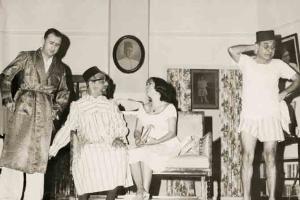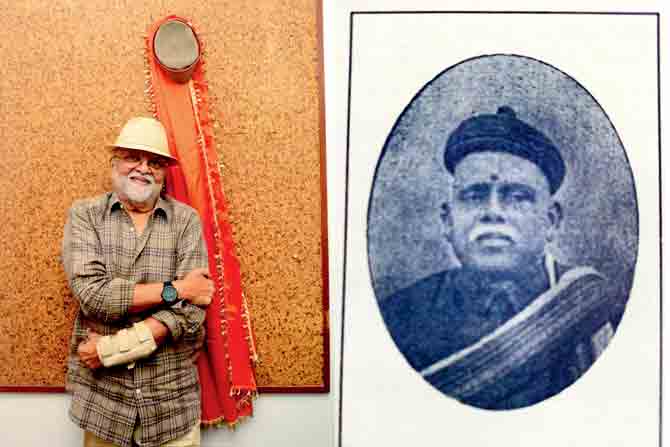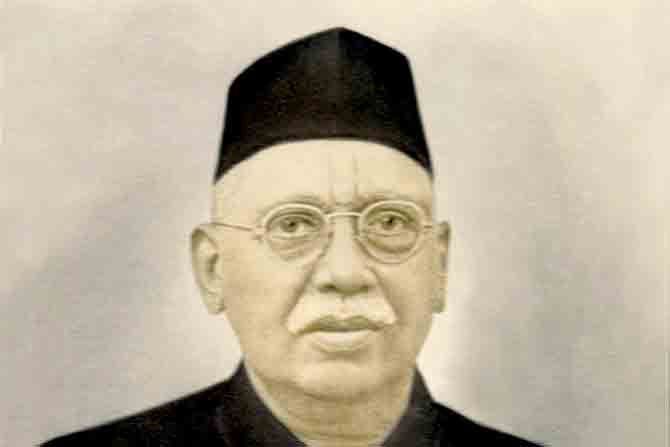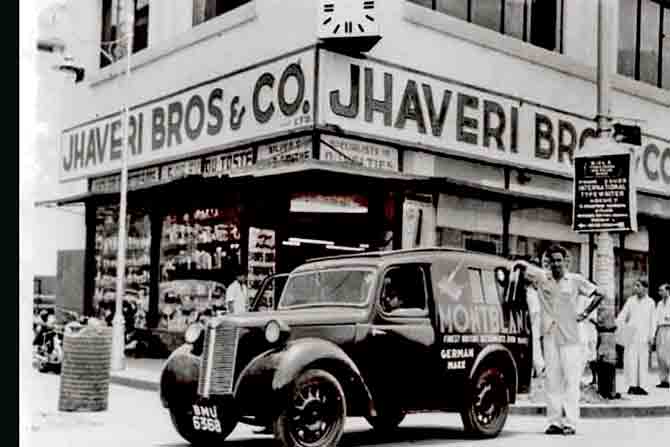Bolting from their village homes to build better lives, plucky young boys landed in Bombay with no more than a coin rattling in ragged pockets. Years of slog later, they contributed considerably as entrepreneurs, entertainers and educationists. Track

Stage comedian Jangoo Irani (extreme right) with Burjor Patel, Dinshah Daji, and Ruby Patel in the Adi Marzban caper, Ari Bethela Erachshah. Pic courtesy/ Meher Marfatia: Laughter in the house: 20-th century Parsi theatre
IT was a camel, a mule and a Karachi-Bombay train that he jumped on. Nothing could stop the 13-year-old peasant boy from Yazd travelling 2,500 kilometres to the city of his dreams in 1929. Khodamurad Meherwan realised his prospects were dim in sleepy Mazrekalantary, where men slaved on dry fruit farms and women stoked kitchen fires in long-sleeved, handwoven dresses worn with white jute slippers called maliki.
"He was running away from no real future in Iran," says Khodamurad's daughter Banoo Kalantary, retracing her feisty father's flight. Stopped at the Afghanistan border on a donkey, Khodamurad was asked his surname. "I don't have one," he replied. That's why he became Khodamurad Meherwan Afkham.
He started sweeping the floor of 1860-established New Majestic Restaurant & Stores below Capitol Cinema at VT for five rupees a day. "My father had no home, only hope, but an attitude of gratitude in his heart," Banoo says. He slept on the footpath outside, with a thin gunny sack lining the cold ground. Slogging for years, he got a modest partner share in Majestic at the age of 20. With his wife Vahbiz, from Alliabadi village, he raised five children in a flat on Gunbow Street, Fort, accommodating an aunt with her five kids too.
ADVERTISEMENT
Khodamurad's first son Jehanbux was born in a goat stable in Iran, the rest here. In a city of military marchpasts on streets that were washed daily, the Afkhams' front door was always wide open. On Fridays, sigri-simmered fish curry was ladled to anyone dropping in. Between chores, the lady of the house somehow caught shows of her adored Raj Kapoor-Nargis starrers at Capitol.

Kapurchand Mehta with Prithviraj Kapoor in 1960. With his brothers Zaverchand and Kevalchand, Kapurchand helmed wide-ranging businesses interests in textiles, real estate and films
Not far from the Afkhams, an iconic cinema and trio of Marine Drive buildings stand centrestage in the story of Nemchand K Mehta's sons. Their grocery-to-glory saga is threaded together by generations after, in Zaver Mahal, Kapur Mahal and Keval Mahal. Nemchand sweated, struggling with meagre earnings from his vegetable shop in Vadal, Saurashtra, to provide for 11 children. Kapurchand, Zaverchand and Kevalchand were born two years apart from 1900 and 1904.
At under 12, Kapurchand boldly left home, walking impossible distances, hopping on to a buffalo buggy and finally steam train. His granddaughter Uma shares an account narrated by her father. "Exhausted and famished, Kapurchand met a woman who gave him one of her two rotlas." He saved a scrap—which, incredibly, Uma has preserved in a casket. "Anything from the hands of a kumarika, an unmarried virgin, was an auspicious shagun offering."
At Bombay Central he was spotted by a Marwari seth and employed in his cloth shop. Buying a lottery ticket, Kapurchand was stunned to find a jingling cascade of coins suddenly his. "Back to work," Nemchand urged his son who returned to Vadal with the surprise treasure. He headed to 1920s Bangalore, opening Kapurchand & Co. in Chickpet. Stocking blankets of the Lal Imli Mills, Kanpur, he invited Zaverchand and Kevalchand to join him.

Filmmaker Vikas Desai at his Rajkamal Studio office stands below the hanging cap of his great-grandfather, Anant Shivaji Desai Topiwala (portrait, right), pre-Independence Bombay’s leading hat maker and pioneer industrialist-philanthropist. Pic/ Bipin Kokate
Bombay beckoning soon, they settled in Prarthna Samaj. Kapurchand shouldered the overall responsibility of their ventures, focusing on finance. With the Lal Imli agency for South India under their belt, Zaverchand managed the Chira Bazaar shop and midtown estates. Kevalchand assumed charge of a film exhibition operation, centred at Roxy on Charni Road, where screen history was rewritten in 1943 with Kismet totting up 192 weeks. Aspiring to a beautiful property each, the brothers commissioned PC Dastoor to create the three buildings.
Another boy bolting from Saurashtra was Shyamdas Govindji Jhaveri, of Kundal in Barwala taluka. A few years after he was orphaned at the age of five, with barely a couple of rupees clinking in his torn pocket, he clocked in unimaginably stretched hours at a Crawford Market stall set up around 1914. Shifting to Metro House, the cinema building, Jhaveri Bros continues to display trophies, silver items and commemorative coins crafted at that counter.
Gradually flourishing, the Jhaveris introduced India to a luxury legend—their door handles are still in the shape of Mont Blanc pens. Adopting the motto, "Customer is master", Shyamdas trained staffers to adhere to ethical standards, meticulously maintaining a file labelled "Thoughts on progressive business". Jhaveri Bros. has witnessed World Wars, civic crises, economic depressions and today's pandemic. Shyamdas' granddaughter Seyjhal says, "We enjoy tremendous trust from local and international clients forever loyal to us."
A humble chana-kurmuri shack he helped his father serve Walawal villagers from, in Sawantwadi, lies at the core of compelling circumstances that brought 10-year-old Anant Shivaji Desai to Bombay. On his father's death, the boy was forced to leave the village with nothing more than a rupee pressed into his hand by a relative. Of which eight annas, or 50 paise, paid for the 13-day boat trip ticket. Two months later, finishing the chinchuk tamarind seeds and kilo of rice his worried mother had packed, he fainted at Grant Road station.

New Majestic Restaurant partner Khodamurad Afkham and his wife Vahbiz with their eldest boy Jehanbux, now a cardiologist in Germany. Jehanbux’s sons are music virtuosos —David Afkham is chief conductor and artistic director of the Spanish National Orchestra and Chorus, while Micha Afkham plays the viola with the Berlin Philharmonic Orchestra. Pic courtesy/ Kalantary Family
Employed as a railway labourer there, he learnt tailoring at a mill during his lunch break. This skill won a series of orders and, by 1872, catapulted him to the status of Bombay's best hat maker with a growing appreciative clientele of Parsis, Muslims and Gujarati seths. They paid well for quality caps fashioned with flair by Anant Shivaji Desai. Titled Rao Bahadur Topiwala by the British, he rose to rank among the richest landlords, whose descendants gifted Bombay the Topiwala Medical College at Bombay Central and Topiwala Theatre in Goregaon.
Anant Shivaji Desai also positioned himself as sole agent for Raja Ravi Varma lithographs, acquiring rights to the Baroda and Mysore collections after the painter's death in 1906. Prise open the frame of a Ravi Varma print and you will most probably read: "Anant Shivaji Desai Topiwala, Ravi Varma Press".
A stitch in time similarly saved Camilo Xavier Pereira from life consigned to the islet of Sao Mathias in Divar. Hugging a "passport" granted by Portuguese authorities then ruling Goa, he bunched meagre savings for steamer fare. In this case, the earnings were from his stint as an eight-year-old muncar (tenant) working for a well-inclined lady badcar (landowning employer). Docking in Bombay harbour, he joined hundreds of other young men from his community, living crammed yet in camaraderie, out of a trunkful of belongings in dormitory quarters called coors—waiting to seize the chance to become seamen, chefs, musicians or Konkani tiatr artistes.
Camilo had figured his forte was sewing. In Dhobi Talao's Sonapur Lane, Tony Pereira points to St Mathias Tailors, where his father's scissors snipped classic 1970s three-pieces for Johnny Walker and Mehmood. And bespoke safari suits for tycoon Pranlal Bhogilal who smiled when Savile Row-accoutred tycoons in London asked with admiring looks, "Who cuts your clothes?"

Shyamdas Jhaveri was the first to import this luxury brand in the country and the shop still has its door handles shaped like Mont Blanc nibbed pens. Pic courtesy/Seyjhal Jhaveri
Equally motivated exits drove starry-eyed boys from small towns to the city they dreamed would never let them down. The success of a pioneer educationist is rooted in kindness—that of institutional legend GD Agrawal of Harganga Mahal at Khodadad Circle, Dadar. He left from Ajmer in his teens, carefully clutching R29 from selling his bicycle. Touched by hungry-to-learn Mazagaon mazdoors' children he saw all over at the height of the city's vibrant textile mills era, he tutored them for free in math and science. Going professional on marrying, Agrawal rented a Matunga room his growing family had to step out from during coaching hours. Agrawal Classes shifted to Harganga Mahal from 1955, their students including Nadir Godrej, Mukesh Ambani and Mahendra Choksi of Asian Paints.
A stowaway from Karachi proving Parsi theatre's extraordinary gain was Jehangir (Jangoo) Irani. The comedian brought the house down as the eccentric domestic help Aspandyar. The third actor essaying this role (predecessor greats were half-French Jean Bhownagary and Pheroze Antia), Jangoo added sparkling touches under Adi Marzban's direction. With a dirty, gingham-check duster slopped across the shoulder and striped shorts ballooning clumsily, he begged a stingy employer for wages.
Hearing excuses like "I pay on the 30th of each month and last month was February", Irani muttered a sulky threat, "Chaal Iran jaaych—I'm off to Iran!"
Fascinated by dramatic showmanship, Jangoo had earlier given Pipsy, his pet squirrel, to visiting Russian circus artistes who taught him stunt cycling and air-gun tricks. His craze to perform made his principal gift him an English bicycle. Scraping through middle school years, he preferred to sit on this cycle perched atop two tables to target-shoot, with candle flames casting flickering shadows around.

An early view of the Jhaveri Bros & Co. corner store at Metro House, with the Mont Blanc van parked in the foreground
Deciding that entertainment-friendly Bombay would be best receptive to his talents, with no money whatsoever, he hushed a chattering black mynah smuggled under his shirt and traded the talking bird for the ship trip. Mechanical-minded, he interviewed with a Godrej firm. At a subsequent job in Central Bank, his acting at annual day skits hooked playwright Pheroze Antia's attention.
The star was the biggest hero to his sons. Shapur Irani recalls he and his brother crept into halls on Sunday evenings to watch their father fire away in the Dari dialect. As he stomped off, mock-huffing, amid loud audience applause, two little lads whispered from the seats, "Chaal Iran jaaych."
Author-publisher Meher Marfatia writes fortnightly on everything that makes her love Mumbai and adore Bombay. Reach her at meher.marfatia@mid-day.com/www.mehermarfatia.com
Catch up on all the latest Mumbai news, crime news, current affairs, and a complete guide from food to things to do and events across Mumbai. Also download the new mid-day Android and iOS apps to get latest updates.
Mid-Day is now on Telegram. Click here to join our channel (@middayinfomedialtd) and stay updated with the latest news
 Subscribe today by clicking the link and stay updated with the latest news!" Click here!
Subscribe today by clicking the link and stay updated with the latest news!" Click here!







